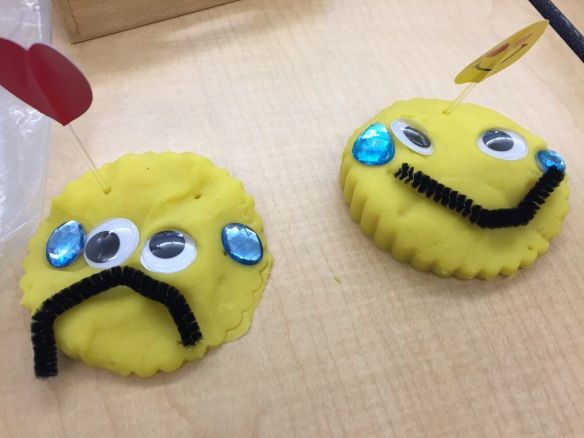
Are your students interested in emojis? Mine are obsessed! We stumbled upon this interest after setting out some loose parts for the children to explore in the first few weeks of school. One student created a “winking emoji” with his loose parts which, when shared with the class, created an uproar of excited children all trying to talk at once about their knowledge of emojis.
Later that week I decided to include emojis in my modeled writing lesson during writer’s workshop. As I was drawing my picture, I drew a thinking bubble above the drawing of myself and put a “love” emoji inside it to show how I was feeling. Once again, my students erupted with excitement! Many children also included emojis in their writing work that day.
This got me thinking. What is it about emojis the children find interesting? How can I use the children’s obvious excitement about them to further our learning? I saw an opportunity to have rich discussions around how we can recognize and communicate our feelings in the modern world. I thought about how I could create an invitation for the children to demonstrate more about what they know.
I decided to go the route of creating a playdough provocation with an emoji focus. I found a printable emoji poster on Teachers Pay Teachers (you can access it here). I made bright yellow playdough (you can find my recipe here) and collected a variety of emoji-inspired objects: circle cookie cutters, blue drop gems, heart gems, black pipe cleaners, small black stones, and googly eyes. The children were VERY excited about this centre! While the children worked, we had an opportunity to talk about what feelings they were representing and what might make someone feel that way.


A “queen emoji”

An “extra extra loving emoji. For when you love someone SO MUCH.”
When sharing our emojis during reflection time, we also started playing a game called “Guess the Emoji” where the children would try to guess what kind of emoji had been created by examining its features. This emoji created some debate:

“It looks like the laughing/crying emoji.”
“Yes. It has two tears.”
“No! It has a sad mouth! It’s a crying emoji!”
“It’s extra sad!”
We continue to talk about why we use emojis and why they are useful for communicating how we feel. The children think of emojis as a way to give someone else a clue about how they are feeling, especially when their face is not immediately visible. The children are now consistently adding emojis to their journal writing as a way of trying to communicate to others how they/others were feeling in their stories. They are also beginning to spot emojis everywhere, which is making them more aware of environmental print. Quite a few children have brought in emoji items from home or things they’ve found when out and about. Emoji lollipops, markers, balls, t-shirts, and stuffies are just some of the items that have come into school! I have a feeling this interest is going to last the whole year long!


Pingback: Playdough Provocations: Emojis! — The Curious Kindergarten | francifularts
Where can I find the mini rolling pins and playdough cutters?
I found mine at the dollar store.
How cute!!! I absolutely love this 🙂
Pingback: “The Way I Feel” Emotion Emoji Activity! – Teach Me Creatively
Pingback: Talk about Emotions with Emoji Playdough – Site Title
Pingback: Talk about Emotions with Emoji Playdough - A Craft Blog
Pingback: Talk about Emotions with Emoji Playdough – KidsGifts
Pingback: 37 Fun Emoji Crafts for Kids - The Activity Mom